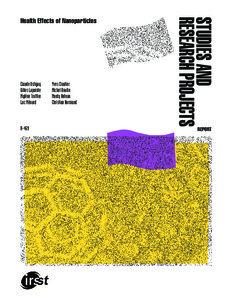Health effects of nanoparticles
"The nanoparticle and nanotechnology field is a fast-growing research niche. Research has already led to significant breakthroughs, and several products are available commercially. It is currently anticipated that the number of exposed Quebec workers, both in use and processing and in productio...
| Main Authors: | , , , , , , , |
|---|---|
| Institution: | ETUI-European Trade Union Institute |
| Format: | TEXT |
| Language: | English |
| Published: |
Montréal
2006
IRSST |
| Subjects: | |
| Online Access: | https://www.labourline.org/KENTIKA-19292409124910106819-Health-effects-of-nanoparticle.htm |
| Summary: | "The nanoparticle and nanotechnology field is a fast-growing research niche. Research has already led to significant breakthroughs, and several products are available commercially. It is currently anticipated that the number of exposed Quebec workers, both in use and processing and in production, will increase over the next few years. The purpose of this literature review is to determine whether nanoparticles represent health risks for workers. The chosen presentation format has the advantage of covering all the aspects that must be considered in toxic risk assessment. For some nanoparticles, the toxicological data are very partial, so this presentation format reveals the scope, and especially the limits, of the information currently available.
Nonetheless, several studies exist on the toxicological properties of nanoparticles. Although the various toxicological aspects and the diversity of the nanomaterials assessed are just beginning, many deleterious effects have been documented, particularly in animals. Insoluble or low solubility nanoparticles are the greatest cause for concern. Several studies have shown that some of them can pass through the various protective barriers of living organisms. The inhaled nanoparticles can end up in the bloodstream after passing through all the respiratory or gastrointestinal protective mechanisms. They are then distributed in the various organs and accumulate at specific sites. They can travel along the olfactory nerves and penetrate directly into the brain, just as they can pass through cell barriers. These properties, extensively studied in pharmacology, could allow organic nanoparticles to be used as vectors to carry medications to targeted body sites. The corollary is that undesirable nanoparticles could be distributed throughout the body of exposed workers. Some of these nanoparticles have shown major toxic effects.
Another special feature of nanoparticles is that their toxicity seems to be linked to their surface. This is a major difference from the usual situations, in which toxicity is normally linked to a product's mass. Nanoparticles are so tiny that small quantities (expressed in terms of mass), could have major toxic effects, because of their large surface. Several studies show much greater toxic effects for the same mass of nanoparticles as compared to the same product with a higher granulometry.
The available studies have shown several effects in animals, depending on the type of nanoparticles. Nephrotoxicity, effects on reproduction and genotoxic effects have been identified so far. Some particles cause granulomas, fibrosis and tumoural reactions in the lungs. Thus, titanium dioxide, a substance recognized as non-toxic, shows high pulmonary toxicity on the nano-scale. Cytotoxic effects have also been reported. …" |
|---|---|
| Physical Description: | 53 p. Digital |

